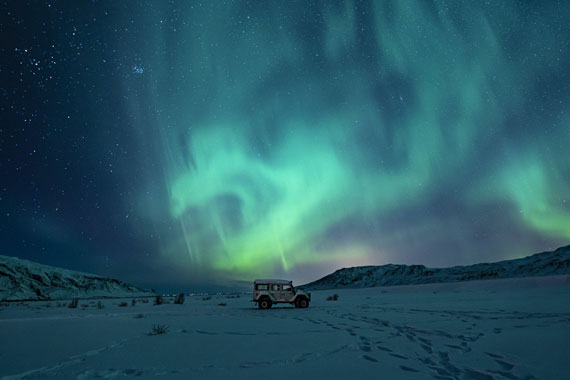Final day: only hours left to get the Photo Adventure Cheat Sheets at 80% Off
Auroras, also known as the Northern and Southern Lights, are one of nature’s most breathtaking displays. These shimmering curtains of light, dancing across the night sky, are a dream subject for many photographers. Capturing their ethereal beauty can be challenging, but with the right knowledge and equipment, you can immortalize these celestial wonders. Here’s a comprehensive guide to help you photograph auroras.

Photo captured by Jonatan Pie; 20mm, f/3.2, 13 seconds, ISO 1250
1. Understand the Science
Auroras are caused by charged particles from the sun colliding with Earth’s magnetic field. The Northern Lights, or Aurora Borealis, are visible in the Northern Hemisphere, while the Southern Lights, or Aurora Australis, are visible in the Southern Hemisphere. Their appearance and intensity are influenced by solar activity, so it’s beneficial to understand the solar cycle and monitor space weather forecasts.
Aurora Forecasting and Apps:
- Space Weather Websites: Websites like the NOAA Space Weather Prediction Center and the Space Weather Live provide forecasts and real-time data on geomagnetic activity.
- Mobile Apps: Apps like “Aurora Forecast” and “My Aurora Forecast” can provide real-time predictions, alerts, and best times to view the lights based on your location.
2. Choose the Right Location
- Latitude: The closer you are to the poles, the better your chances. Popular locations include Norway, Iceland, Canada, and Alaska for the Northern Lights, and Australia, New Zealand, and Antarctica for the Southern Lights.
- Darkness: Avoid light pollution. Move away from city lights and find a spot with a clear, unobstructed view of the horizon.
- Weather: Clear skies are essential. Monitor local weather forecasts and aim for nights with minimal cloud cover.
3. Timing is Everything
- Time of Year: Winter months offer longer nights and often clearer skies. In the far north, the polar night provides 24 hours of darkness, maximizing your chances.
- Solar Activity: Monitor the Kp-index, a measure of geomagnetic activity. Higher values (4 and above) indicate stronger auroral activity.
- Moon Phases: A darker sky provides better contrast for auroras. Planning your trip around the new moon phase can be beneficial.
4. Gear Up
- Camera: A DSLR or mirrorless camera with manual settings is ideal.
- Lens: A fast wide-angle lens (e.g., f/2.8 or faster) is preferable. It allows more light in and captures a broader swath of the sky.
- Tripod: Essential for stability during long exposures.
- Extra Batteries: Cold conditions can drain batteries quickly.
5. Camera Settings
- Focus: Set your lens to manual focus and adjust it to infinity. Some photographers use a bright star or distant light to help set focus.
- Aperture: Use the widest setting (smallest f-number) to allow maximum light.
- Shutter Speed: Start with 5-20 seconds. If the aurora is moving quickly, you might need a shorter exposure to capture details.
- ISO: Begin with 800-1600. Adjust as needed based on the aurora’s brightness and desired noise levels.
- White Balance: Set to daylight or auto. However, you can adjust this in post-processing if shooting in RAW.
6. Composition
- Foreground Interest: Including an interesting foreground (e.g., trees, mountains, or reflective water bodies) can add depth and scale to your images.
- Rule of Thirds: Position the aurora along one of the imaginary lines dividing your frame into thirds for a balanced composition.
7. Be Patient and Persistent
Auroras can be unpredictable. You might wait hours without any activity, only to witness a sudden burst of light. Stay patient, keep warm, and be ready to adjust your settings as the display evolves. Stay flexible, it might be helpful to have a flexible itinerary if you’re traveling specifically to see them. This allows you to move to different locations based on the forecast or cloud cover.
8. Post-Processing
- RAW Files: Shooting in RAW gives you more flexibility in post-processing. Adjust exposure, white balance, and clarity to bring out the best in your aurora images.
- Noise Reduction: Use software like Topaz Photo AI, Adobe Lightroom or Photoshop to reduce noise resulting from high ISO settings.
Photographing auroras is a blend of preparation, understanding, and a touch of luck. With the right approach and a bit of persistence, you can capture the mesmerizing dance of lights that few get to witness in person. Whether you’re a seasoned pro or a budding enthusiast, the thrill of capturing an aurora is an experience like no other. Happy shooting!
For Further Training, Offer Ending Tonight:
For help remembering these concepts and more help on the Most Difficult Photography Situations, this new set of Photography Adventure Cheat Sheets have you covered. They are currently 80% off until the end of the month, September 30, if you want to check them out.
The perfect companion for any photographer. Print one out whenever you need it. Whether you’re going on vacation or seeking out a specific photography adventure, these cheat sheets can provide you with the knowledge and inspiration you need to create your best work yet.
Only hours left: The Photography Adventure Cheat Sheets at 80% Off
- - - - - - - - - - - - - - - - - - - - - - - - - - - - - - - - - - - - - - - - - - - - - - - - - - - - - - - - - - - - - - - - - - - - - - - - - -
Did you appreciate this newsletter? Please help us keep it going by Joining Our Patreon Supporters
What are your thoughts on this article? Join the discussion on our Facebook Page
PictureCorrect subscribers can also learn more today with our #1 bestseller: The Photography Tutorial eBook
- - - - - - - - - - - - - - - - - - - - - - - - - - - - - - - - - - - - - - - - - - - - - - - - - - - - - - - - - - - - - - - - - - - - - - - - - -
The post How to Photograph Auroras appeared first on PictureCorrect.
from PictureCorrect https://ift.tt/MhLk5XY
via IFTTT







0 kommenttia:
Lähetä kommentti